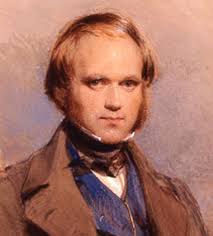A POPULATION IS THE SMALLEST UNIT THAT CAN EVOLVE
Darwin:
born/died- 1809-1882
1831- sailed on the Beagle, spent most of his time on shore studying the plants and animals off the coast of South America.
- noted that the plants and animals intemperate regions of south America were more closely related to South American tropics than species in temperate Europe.
- the fossils he found, though different from the living species he studied, there was a resemblance between the fossils in South America and the species in South America, not the same as the species or fossils in Europe
- published his theory in The Origin of Species
- evolution explains life's unity and diversity
- natural selection is a cause of adaptive evolution
* Darwin did not use the word evolution until the very end of his book, but instead used Descent with modification (Darwin's view of life)

- All the changes that have transformed life on earth from its earliest beginnings to the diversity that characterizes it today.
Gradualism- a view of earth's history that attributes profound change to the cumulative product of slow but continuous processes
Common Ancestor- descend from a common gene pool
Natural Selection- differential success in the production of different phenotypes resulting from the interaction of organisms with their environment. evolution occurs when natural selection causes changes in relative frequencies of alleles in the gene pool
Variation- differences between members of the same species
Homologous Structures- structures in different species that are similar because of common ancestry
Analogous Structures- structures in different species that are similar because of convergent evolution
Genetic Drift- unpredictable fluctuations in allele frequencies from one generation to the next because of a populations finite size
Adaptive Radiation- the emergence of numerous species from a common ancestor introduced into an environment that presents a diversity of new opportunities and challenges
Modes of Natural Selection
- Directional Selection: favors individuals at one end of the phenotypic selection
- Stabilizing Selection: favors intermediate variants by acting against extreme phenotypes
- Diversifying Selection: favors extreme over intermediate phenotypes

Hardy-Weinberg Equilibrium: the condition describing a non-evolving population (one that is in genetic equilibrium)
- p2+2pq+q2=1
- p+q=1
- p= frequency of the dominant allele in the population
- q= frequency of the recessive allele in the population
- p2= percentage of homozygous dominant individuals
- q2= percentage of homozygous recessive individuals
- 2pq= percentage of heterozygote individuals
Punctuated Equilibrium- in evolutionary theory, long periods of apparent stasis (no change) interrupted by relatively brief periods of sudden change
Bottlenect Effect- genetic drift resulting from the reduction of a population, typically by a natural disaster, such that surviving population is no longer genetically representative of the original population
Founder Effect- genetic drift that occurs when a few individuals become isolated from a longer population with the results that the new populations gene pool is not reflective of the original population
1. what is generally true of two very closely related species that have diverged from each other quite recently?
a. they are unable to produce hybrid offspring upon interbreeding
b. their reproductive isolation from each other is complete
c. they share a common ancestor recently in evolutionary time
d. genes are unable to pass from one species' gene pool to the other's gene pool
2. if the curve shifts to the left or to the right, there is no gene flow, and the population size consequently increases over successive generations, then which of these is (are) probably occurring?
a. directional selection
b. adaption
c. all of the above
d. none of the above
3. the ability to roll one's tongue, allele (R), is dominant over the absence of this ability, allele (r). in a population of 1000 people, 640 have the ability and 360 do not. what is the frequency of allele (r) in this population? (assume HW equilibrium)
a. .7
b. .6
c. .64
d. .36
1. c, 2. c, 3. b
No comments:
Post a Comment